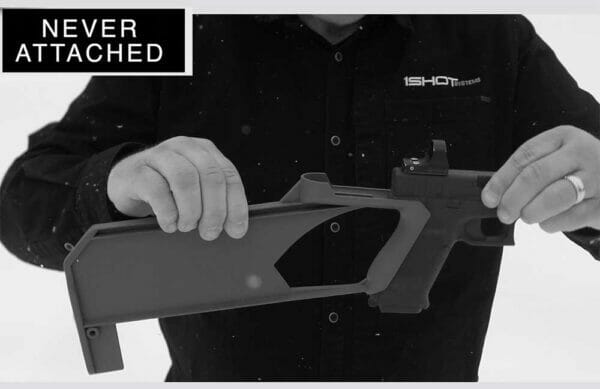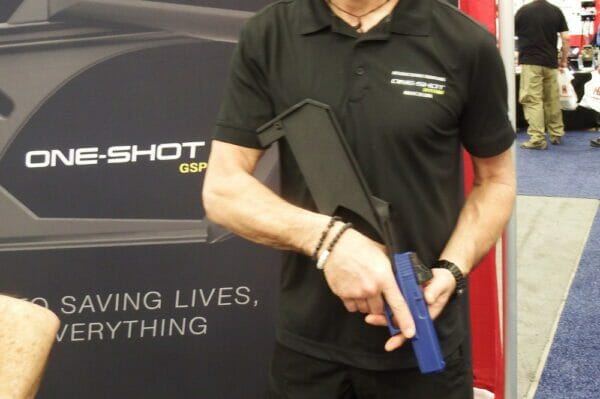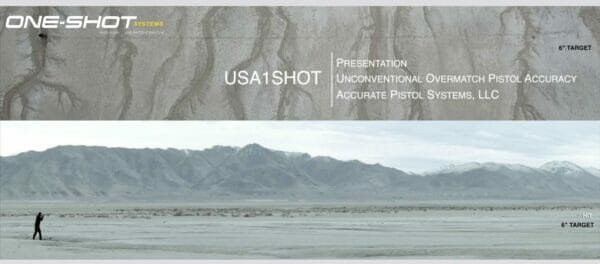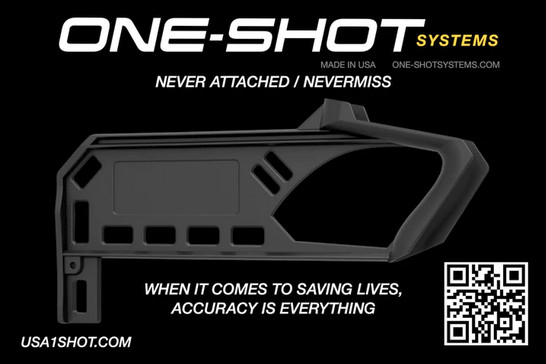
U.S.A. — At the NRA Annual Meeting in Indianapolis, One-Shot Systems was offering pre-orders to the public for the new, improved version of their highly successful, non-attached pistol stabilization system. The product has been in use, particularly in the US military and with law enforcement agencies, for a decade. The improved design is now being offered to the general public. The early versions were built for the Special Forces community. The product has been continuously improved and is now in use at over a hundred agencies, including the Secret Service and U.S. Border Patrol.
The concept of a solid rest to stabilize a pistol, which is not attached to the pistol and, thus, not a firearms part, has been in the gun culture for a very long time. Using a walking stick to stabilize a pistol has been fairly common, even if the stability came from the ground and not the shooter’s shoulder. The idea of a stick, held by the shooter’s hand against the pistol grip, has been considered, on and off, for as long as pistols have existed. An intermediate form is the hip stick. While helpful, these systems do not approach the advantages that accrue while using the one-shot design.

A major advantage of the latest one-shot design is its simplicity. It is a simple, solid, tough piece of special reinforced composite material. No adjustment is necessary. When you grip the pistol and the one-shot, your grip holds them together in a unique way that prevents side-to-side wobble or up-and-down angular rotation between the pistol and the one-shot. The one-shot design only weighs seven ounces. It is eleven inches long. There is no attachment to the pistol. When the user stops gripping the pistol, the one-shot separates automatically. Therefore, it is easy to holster the pistol. Just holster it as you normally would, and the one-shot moves from it. If you have the one-shot in your hand, placing it on the pistol grip as you draw the pistol is said to be almost as quick as a normal draw. With the one-shot, you are drawing the equivalent of a pistol caliber carbine, with all the advantages in accuracy and control.
The simple system has made this correspondent re-think the entire “pistol brace” controversy. The one-shot sidesteps the entire issue. It is not a firearm part. It never attaches to the firearm. It is a sophisticated type of rest, not much different in function from a stick. It is not regulated as a firearm part because it is not a firearm part. This correspondent was told there is no issue in carrying it aboard commercial aircraft in carry-on luggage.

One of the difficulties of using pistols at longer ranges has been the short sight radius. A modern solution is a micro-optical sight. Someone with excellent eyes and good support can hit beer cans at 70 yards with a snub-nosed revolver. I could do it while I was on the University of Wisconsin Pistol Team in the 1970s. It takes good eyes and solid support. Sight alignment is critical. Modern micro-optical sights eliminate most sighting errors. The one-shot system excels at support to minimize wander and wobble in nearly all situations. The combination produces a system that is the equivalent of a pistol caliber carbine, with significant advantages and slight disadvantages. This means, with most pistol calibers, first-shot hits on man-sized targets out to 150 yards are not difficult. First-shot hits on small game out to 50 yards are not difficult. If you can hit what you are aiming at with an ordinary .22 rifle, you can almost certainly hit it with a pistol equipped with an optical sight and a one-shot. The inherent accuracy of the pistol used limits this. Most modern pistols are surprisingly accurate.
A major advantage is the ability to holster the pistol so as to be free of encumbrances. Another is the extremely compact package which can be brought into play in a couple of seconds without adjustment or set screws.
The minor disadvantage is the one-shot and pistol together are not an effective blunt instrument. They can be used separately. Being a blunt instrument was never a great selling point for shoulder-stocked pistols.
While the one-shot appears to be simple, it represents years of continual improvement and sophisticated features. The contact between the pistol, the one-shot, and the human hand has been refined to work extremely well with many semi-automatic pistols. The part of the one-shot which accepts the slide as it recoils both aids in stability and protects the user’s hand, face, and eye. The variety of slots reduces weight and allows for multiple sling methods of carrying the one-shot for rapid employment. The asymmetrical shape of the contact area increases the stability of the system. The sophisticated composite material is very strong. There are a number of patents on the design.

Unfortunately, the one-shot system’s advance samples were unavailable at the NRA Annual Meeting. The prototypes examined by this correspondent were simple, light, compact, and impressive in their ability to stabilize a pistol into the equivalent of a pistol caliber carbine. This correspondent hopes to test one of the early production models with actual range and field time. The one-shot product can be pre-ordered for $99 at usa1shot.com. The official release date is July 4, 2023.
One-shot is said to have earned its name from people who used earlier versions in the field, and marveled at a pistol’s increased practical accuracy. It is virtually unregulated by any firearms law. Long experience by over a hundred agencies has shown it to be useful and effective.

About Dean Weingarten:
Dean Weingarten has been a peace officer, a military officer, was on the University of Wisconsin Pistol Team for four years, and was first certified to teach firearms safety in 1973. He taught the Arizona concealed carry course for fifteen years until the goal of Constitutional Carry was attained. He has degrees in meteorology and mining engineering, and retired from the Department of Defense after a 30 year career in Army Research, Development, Testing, and Evaluation.

